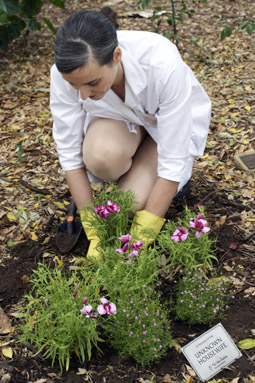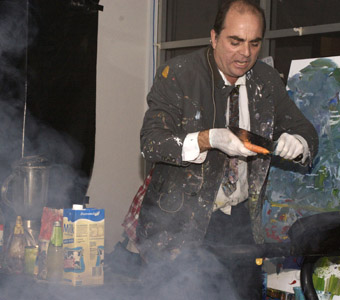utopia reconsidered
dan mackinlay: electrofringe 2009

Elke Reinhuber, The Urban Beautician – In Honour of the Unknown Housewife
photo Torunn Higgins
Elke Reinhuber, The Urban Beautician – In Honour of the Unknown Housewife
A KIND OF DILUTED CASUAL URBAN INTERVENTION, OR A PERFORMANCE INSTALLATION FOR THE SUNDAY ARVO BARBEQUE SET? THIS FESTIVAL IS OBSTREPEROUS, YES, BUT IT IS OTHER THAN THE ADOLESCENT AGITATION I REMEMBER WHEN IT TESTED THE CONSTRAINTS OF ITS HOME TOWN A FEW YEARS AGO. IT IS AS IF THE TROUBLESOME SON OF NEWCASTLE HAS MELLOWED, MAYBE RETURNED HOME FOR A WEEK OF CAMPING OUT IN THE LIVING ROOM AND SCABBING LUNCH FROM THE FREEZER. IT EVEN FEELS LIKE WE MIGHT BE WELCOME HERE, FOR ONCE, AS LONG AS WE DON’T LEAVE A MESS IN THE KITCHEN. WE’VE BOTH MOVED ON SINCE THE OLD DAYS, AFTER ALL.
Elke Reinhuber’s domestic performance installation is the crowning hair bun atop the domestic festive spirit. Dressed in the white salon uniform of her “Urban Beautician” persona, she dusts and preens Civic Park as one prepared to lift the corner of the public fountain to dust beneath. Her ultimate intervention is pointedly humble; amidst the plaques to sundry wars and dead local soldiers, she plants flowers, parsley and a memorial plate dedicated to the honour of the Unknown Housewife. Pointed, and displaying anything but the belligerence of the camp of cyberpunk squatters whose stand occupied that same spot in my very first Electrofringe.
The centre of gravity of the festival is not Civic Park this year, mind. Rather, the locus has shifted east to the Renew Newcastle project. There, in the Hunter Street pedestrian mall, an assortment of otherwise disused restaurants and shopfronts have been fished from the jetsam of the shopping strip’s economic shipwreck and converted into art spaces. This arts-space-brokering project has been getting reasonable coverage for its year-round urban revitalisation, and achieves serious momentum by festival time. The spaces are not all at the service of the festival by any means. Indeed, in this diversity of projects there are several that sit below the line of acceptable minimum irony for us Electrofringe crowd. Nonetheless, a goodly proportion are venues—it is Renew Newcastle that provides the wealth of spaces for the festival, and that, perhaps, lends this entire event part of its homely air, with the selection of hand-decorated, informal, idiosyncratic galleries, cafes, boutiques and craft stalls.

The Vinyl Arcade, Lucas Abela with Fred Rodrigues
photo Torunn Higgins
The Vinyl Arcade, Lucas Abela with Fred Rodrigues
Vinyl Arcade (Lucas Abela with Fred Rodrigues) is one such space, wedged between the souvenir and trouser shops. The basement floor of this crypto installation is covered with discarded records, traversed by a toy truck with a record stylus in its undercarriage. Some ingenious sytem of cabling or radio transmitters relays amplified cracks and squeals from the abused needle to the sound system. From the showroom above, the device is remotely operated by boisterously hoonish punters made instantly puerile by that most dangerous of lures, the artistically validated children’s toy. The thumps and clicks of abused records provide a ludic, tactile experience of noise art your grandmother would queue to have a go at. As far as engagement goes, it trounces Abela’s older sit-quiet-while-I-smash-some-glass-on-my-face thing.
Across the way, dLux’s new exhibition, The Garden of Forking Paths, also repays the investment of some playtime. It’s a simple show, computer-game-based art, spanning significant works from the last few decades. Featured pieces include Jaron Lanier’s 1983 Commodore 64 work Moondust, and a 1995 Laurie Anderson interactive CD—from that primordial time when terms like “virtual reality” and “multimedia” seemed to denote intrinsically interesting concepts to entities apart from Australian arts funding bodies. But in context, what may once have seemed grand utopian futurism takes on unassuming playfulness. To my over-stimulated eye, the second instalment of Anita Fontaine and Mike Pelletier’s hallucinatory CuteXDoom game is a addictive, although a more restrained piece, The Path, by Belgian team Tale of Tales, might have weathered better on a less hung-over morning. Neil Jenkin’s curation here creates an exuberant and unitary experience from the DIY psychedelia of Electrofringe and the commercial world of name-brand art, and ties it all together with comfy chairs.
In other mall venues, the space itself is remarkable enough as to be a work in its own right. The most prominent examples are the conversion of two levels of the King Street carpark into an ad hoc zine fair, and the wildly popular op-shop-chic Tortoro’s Tea House in the mall, created by Maddy Phelan. My favourite, though, is the Renew Church, a hidden paragon of 70s architecture just off the main drag that now houses the Renew Newcastle project headquarters. It transpires that a good performance venue transcends both decades and denominations, and the suburban-sacred backdrop is an intriguingly apposite setting for Christian Haines and Paul Gough’s performances. Haines’ delicious spacious tonescape for multiple mobile phones in a darkened room would be worth a listen anywhere, but there is something deeply satisfying about a work based on other people’s phones going off in this most hushed of places. The audio visual works that follow are lovely enough, but none of them elicit, as this one did, a shared sigh from the audience at the end.

John Kilduff, Let’s Paint TV
photo Torunn Higgins
John Kilduff, Let’s Paint TV
Just down the way, perched above the discount store, is that remarkable venue, the China Club. Of the various shows therein, the most unmissable, and the hardest to miss, is Let’s Paint TV: part performance installation, part public sanitation disaster. Curated by Tim Dwyer, the show pits Los Angeles cable TV sensation John Kilduff against a succession of local artists, a selection of exercise equipment and oil paints. The performer splashes some portion of his ill-mixed pigment on the canvas from a walking treadmill and the rest ends up pooling in a puddle of public liability risk. Professing to instruct in cocktail mixing, oil painting and life-coaching simultaneously, Kilduff’s performances are unrelenting to the edge of cringemaking. His persona, a multi-tasking agony aunt, intercuts his painting with trite life advice, re-inventing platitudes of the ‘everyone is an artist’ DIY ethos as daytime television infotainment. With cameo appearances from a reasonable sampling of every performance artist who has ever been inappropriately naked or messy in a Sydney venue of late, the show is possibly the boldest example of the promiscuous collaboration that Electrofringe has made its name, facilitating at the instant that it mocks what the whole thing stands for.
Oh, and there’s also some obligatory twitter-based artwork, and video installations, and enough firewire leads to span the continent. It is Electrofringe after all. But that old focus on technology, and on the strident politics of participation, are backgrounded, uncontroversial. We’re in a society which mainstreams the debauched participation of Burning Man, where culture jamming is repackaged as community cultural development, and where flashmobs and programmable GPS devices provide ubiquitous recreation for the middle class. Newcastle itself doesn’t seem to feel obliged to muster up the objections it might once have in the face of such a spectacle. I’m hard put to explain whether the festival has lost its edge to an advancing society, or is simply representing a more acceptable, even attainable, vision of change than its earlier utopianism. Or am I’m calling the truce too early?
On the final night, the neo-tribalism of New Weird Australia takes over the festival club, in a gentle reassurance that this last possibility is in the race. This is a new music project curated by Stuart Buchanan and Danny Jumpertz (see earbash review), defiantly audio-focussed, refreshingly free from video projectors. NWA’s hand-picked miscellany of musical outsiders offer essays in low-fidelity technopunk, and there is no-one, (out-of-townsfolk nor festival managers) who is safe from the generalised wantonness. It’s hard to say in the mayhem, but I think I catch Alps, Moonmilk and Brutal Hate Mosh performances. Second-hand effects units and broken samplers abound, pumping distorted audio through an overdriven sound system in the old Masonic Hall, obliterating any compering that might bring order to the mess. This is an ‘experimental’ evening in the older sense I still expect from this festival, not as a category in the iTunes store, but in the sense of trying something raw enough that it might not work. It doesn’t, sometimes, and at other times it does, and the frenetic crowd loves the lot. As the licensing police descend on the venue for the 10pm crackdown, and drunken, intoxicated freaks are disgorged onto the streets, as the cascading parties are evicted from corner after corner and squat party after squat party is quashed by noise complaints, the festival finally discovers the limits of this city’s tolerance. There is still, I see, tension enough between the forces of the centre and the fringe to keep the interaction entertaining.
Electrofringe 2009, directors Somaya Langley, Daniel Green, This Is Not Art, Newcastle, Oct 1-5, www.electrofringe.net
RealTime issue #94 Dec-Jan 2009 pg. 30






